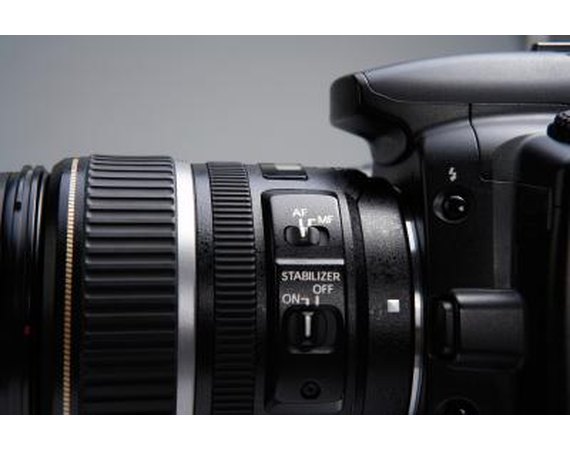
Photography can be a reflection of culture and history. Critical theory examines the rapid emergence of visual arts and photography's role as a visual medium. Images express ideas, emotions, news, even provide income. Photo theory examines photography through aestheticism, commercial, scientific and journalistic lenses.
Fine Art
A traditional Renaissance perspective of fine art conveys a timeless image. England and the United States were introduced to fine art photography around 1890. The photographer captures a moment in time and place. Photography came to represent an intellectual progressive. Images can take on a different interpretation than the photographer's intent. LIke abstract painting, the photo takes on multiple meanings.
Modernism
During the first two decades of the 20th century, modernism produced a major shift in art. Modernism implies the disapproval of tradition in favor of radically different expression. Real, candid shots make up the majority of Modernist works. Photographers focused on exploiting disreputable industries.Photography became an important outlet for the formerly repressed social realities in America during the 1950s.
Commercial Photography
John Berger's "Ways of Seeing" looks critically at photography in modern consumerist society. Images are an effective means of advertisement. Photography has merged with business to justify the exposure of images in this way. People are meant to see the images and believe the product will make their lives better. The viewer becomes enviable and associates the image with a glamorous lifestyle. Berger points out that they surround us, and that this is unique to modern society.
Documentation
After World War I the world gave more attention to photography and its further production for the public. As photography became an elemental component of journalism, newsworthy events were captured on camera. Photojournalism was a timely profession that adapted to the dominance of lens-based art. Photography was quick and images could be produced rapidly -- it was a speedy technology.

Photography can be a reflection of culture and history. Critical theory examines the rapid emergence of visual arts and photography's role as a visual medium. Images express ideas, emotions, news, even provide income. Photo theory examines photography through aestheticism, commercial, scientific and journalistic lenses.
Fine Art
A traditional Renaissance perspective of fine art conveys a timeless image. England and the United States were introduced to fine art photography around 1890. The photographer captures a moment in time and place. Photography came to represent an intellectual progressive. Images can take on a different interpretation than the photographer's intent. LIke abstract painting, the photo takes on multiple meanings.
Modernism
During the first two decades of the 20th century, modernism produced a major shift in art. Modernism implies the disapproval of tradition in favor of radically different expression. Real, candid shots make up the majority of Modernist works. Photographers focused on exploiting disreputable industries.Photography became an important outlet for the formerly repressed social realities in America during the 1950s.
Commercial Photography
John Berger's "Ways of Seeing" looks critically at photography in modern consumerist society. Images are an effective means of advertisement. Photography has merged with business to justify the exposure of images in this way. People are meant to see the images and believe the product will make their lives better. The viewer becomes enviable and associates the image with a glamorous lifestyle. Berger points out that they surround us, and that this is unique to modern society.
Documentation
After World War I the world gave more attention to photography and its further production for the public. As photography became an elemental component of journalism, newsworthy events were captured on camera. Photojournalism was a timely profession that adapted to the dominance of lens-based art. Photography was quick and images could be produced rapidly -- it was a speedy technology.
The Big Bang Theory - Wikipedia, the free encyclopedia
en.wikipedia.org/wiki/The_Big_Bang_TheoryThe Big Bang Theory is an American sitcom created by Chuck Lorre and Bill Prady, both of whom serve as executive producers on the show along with Steven Molaro. All ...
The Big Bang Theory (TV Series 2007 ) - IMDb
www.imdb.com/title/tt0898266Leonard Hofstadter and Sheldon Cooper are both brilliant physicists working at Caltech in Pasadena, California. They are colleagues, best friends, and roommates ...
Chaos theory - Wikipedia, the free encyclopedia
en.wikipedia.org/wiki/Chaos_theoryChaos theory is a field of study in mathematics, with applications in several disciplines including physics, engineering, economics and biology. Chaos theory studies ...
The Jerk Theory (2009) - IMDb
www.imdb.com/title/tt1145157An aspiring recording artist, Adam, is burned by a bad relationship experience and decides that if women won't respond to the "nice guy" then he'll be "the jerk ...
The Big Bang Theory Site
the-big-bang-theory.comA fan site for the hit CBS TV show The Big Bang Theory. Get news, episode information and more.
The Big Bang Theory
www.cbs.com/shows/big_bang_theoryCast Episodes Video Kaley CuocoWatch full episodes of The Big Bang Theory, view video clips and browse photos on CBS.com. Join the conversation and connect with CBS\'s The Big Bang Theory.
(Notes on) Politics, Theory & Photography
politicstheoryphotography.blogspot.com(Notes on) Politics, Theory & Photography What we need is a critique of visual culture that is alert to the power of images for good and evil and that is capable ...
THE ANOMALIST: World News on UFOs, Bigfoot, the Paranormal,
www.anomalist.comThe Anomalist is a daily review of world news on maverick science, unexplained mysteries, unorthodox theories, and unexpected discoveries.
0 comments:
Post a Comment